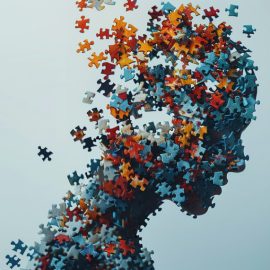
How does your unconscious mind influence your daily life? What evolutionary advantages do these unseen mental processes provide?
In his book Subliminal, Leonard Mlodinow reveals how unconscious processing drives most of our brain activity. He explains that this gives rise to a couple of abilities that helped our ancestors survive and continue to shape our experiences today.
Keep reading to discover how your brain’s hidden operations might be making the difference between life and death without you even realizing it.
Unconscious Processing
Modern technology has shown that our unconscious mind drives the lion’s share of everyday brain functioning, but why is this the case? Mlodinow explains that unconscious processing serves two crucial evolutionary functions: It enables us to process information more quickly and efficiently, and it helps us synthesize and interpret vast amounts of sensory data. Both of these evolutionary advantages helped our ancestors survive in a dangerous and uncertain world, and we’d struggle to navigate the complex world we live in today without these abilities.
#1: Efficient Use of Brain Power
Mlodinow points out that we can pay attention to only a limited number of things simultaneously. So when the brain delegates routine tasks to unconscious systems, it frees up conscious attention and processing power for more demanding tasks. For instance, when you’re driving a familiar route, your unconscious mind can handle basic operations like making sure you stay in your lane and maintain an appropriate speed, which leaves your conscious mind free to plan your day, deliberate about whether you have enough time to stop for coffee, or consider a problem you’re trying to solve at work.
The brain’s ability to delegate cognitive processes to the unconscious mind also makes those processes faster and more efficient: Unconscious processes can rapidly evaluate and respond to environmental cues without the bottleneck of conscious deliberation. Mlodinow notes this proves particularly useful in situations that require fast reactions, like when we need to act quickly to avoid a threat or seize an opportunity. Mlodinow explains that our conscious processing would be too slow to respond effectively in many of these situations, and sometimes, our reliance on our unconscious abilities can make the difference between life and death.
(Shortform note: The classic example of how delegating tasks to unconscious processing enables us to respond more quickly involves our brain’s ability to detect and respond to threats like snakes. Research shows that information about potential dangers can reach the amygdala—our brain’s threat-detection center—through a direct neural pathway that bypasses conscious awareness entirely. This means we can literally jump away from a snake before we’re consciously aware we’ve seen one.)
| The Efficiency of Autopilot Mlodinow’s insight that unconscious processing helps us use our cognitive resources more efficiently is powerfully illustrated by research on the common experience of “highway hypnosis,” a phenomenon where we arrive at our destination with little memory of the actual drive. While this might seem dangerous, research suggests it’s an example of our brain’s remarkable efficiency: When driving a route we know well, our unconscious mind can handle the routine aspects of the drive while letting our conscious mind focus elsewhere. This efficiency comes with a trade-off: As tasks become more automatic, our brain starts to rely less on what we’re seeing and more on what it expects to see. On a familiar drive, for example, our visual system begins depending more on the brain’s predictions of what we’ll see along the route than actual visual input. This helps explain both why unconscious processing is so efficient—it doesn’t need to process every detail—and why it works best for familiar, predictable situations—it relies heavily on learned patterns—but can be dangerous when we encounter unexpected circumstances that require conscious attention and novel responses. In other words, conscious attention and thinking play an important role when we need to deal with new situations or break out of automatic patterns. |
#2: Synthesis of Sensory Data
Unconscious processing gives us another useful tool: the ability to integrate multiple streams of information to make sense of ambiguous or incomplete data. Mlodinow explains that the unconscious mind can detect patterns, make inferences, and fill in gaps based on what we’ve learned and seen in the past. For example, when you walk into a room and sense tension between two people, your unconscious mind has already processed cues like their facial expressions, tone of voice, and positioning relative to one another before you can consciously analyze the situation. Your conscious mind will catch up, but your unconscious mind understands the situation almost immediately, which enables you to behave appropriately.
(Shortform note: As Mlodinow points out, unconscious processing enables us to complete complex tasks—like reading a room’s social dynamics and responding accordingly—by quickly synthesizing various types of information. However, research reveals that processing social information like this is more cognitively demanding than it might appear. The process can temporarily deplete our mental resources—even when we’re not aware of this depletion happening. For instance, after engaging in interactions that require careful self-presentation, like walking into a room where they’re trying to make a good impression on someone important, people often perform worse on completely unrelated tasks that require mental control.)






